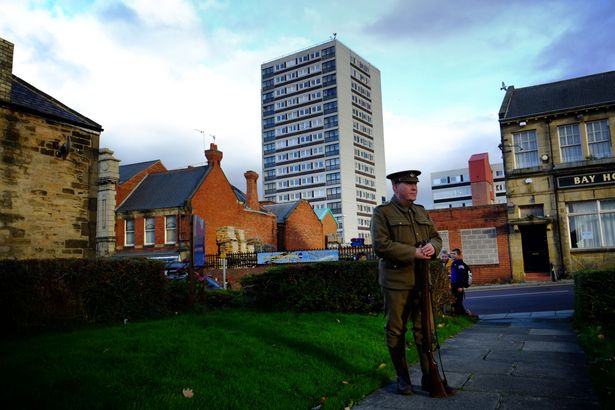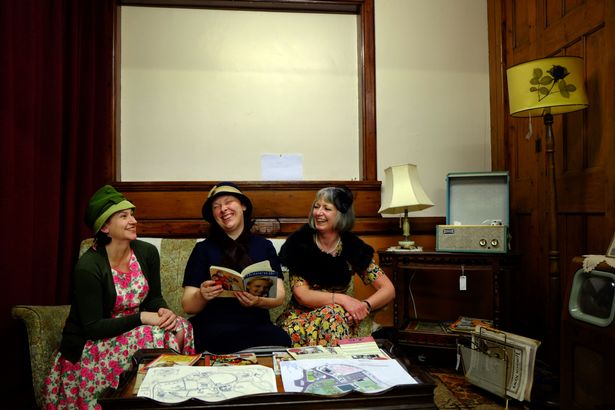Exhibitions..cont..d
2015 History Exhibition
Evening Chronicle Write Up
Depending on who you listen to, the Gateshead borough of Felling gave us the term ‘Geordie’.
In the wake of the 1812 mine disaster, inventor George Stephenson designed a safety lamp, which became known as the Geordie Lamp - but more on that later.
The Felling Heritage Group, which works to preserve the rich history of the town, held a special exhibition to tell people.
From the first train to pass through the town to the Heworth stocks used for 18th century hoodlums, and the Felling Whale Factory. David Napier is a former Felling councillor and is now a member of the heritage group. The retired radio and television engineer was born in the town, living there to this day. Now 68, he devotes his time to the Felling Heritage Group. He said: “It’s something we took up about three years ago. I first got involved for the 200 year anniversary of the pit disaster. Back then the group was called Felling Then and Now.” The last two years has seen the group go from strength to strength, fuelled by the noble notion that preserving the history of this old mining town is worthwhile.
Felling is an area in the east of Gateshead and was once known for its mining and shipbuilding industries. Its name derives from the area where trees were felled to the east of town and is often referred to locally as “the Felling”. On May 25, 1812 it was the site of one of the first major pit disasters in Britain, which killed 91 men and boys. An explosion ripped though the mine at Felling Colliery, while 128 were working away. Three quarters of them perished. The accident was caused by ignition of firedamp (methane) which then triggered a coal dust explosion. The disaster became famous because it stimulated a then unknown engineer, George Stephenson, to design a safety lamp with air fed through narrow tubes, down which a flame could not move. It became known as a Geordie lamp and it’s one of the more prominent sources for the affectionate term used for people from Newcastle. Felling Colliery, formerly known as Brandling Colliery, closed in 1931 but reminders of it can still be seen today. The Felling Heritage Group work tirelessly to preserve knowledge about the area, and those at the exhibition would have found out several interesting nuggets of information. Coal was mined in Felling early in the 17th century, but Felling Colliery was not opened until 1779. It was then extended in 1810 but closed in 1931. Friar’s Goose Chemical Works, which opened in 1827 by Anthony Clapham, a soap manufacturer was one of the most important factories in Felling. In 1833 the 263 feet high Clapham Chimney was built, and at the time was the tallest chimney on Tyneside. After the chemical works went out of use in 1932 the two million ton spoil heap was utilised for agricultural purposes, and the recovered land became East Gateshead Riverside Park in 1966. Felling was also deeply involved in the Tyneside shipbuilding industry. Mitchison’s Ship Repair Yard replaced Fair’s boat yard in 1919, but closed in 1964.
Brandling Station, opposite Felling Metro Station, was built in 1842 for the Brandling Junction Railway and is one of the oldest passenger stations in England. The former Felling UDC Council Offices, are now used as a refugee lodging. Above the main door is a crest which was adopted by the council but which was originally the crest of the Brandling family. The original St Patrick’s RC Chapel was at Felling Shore, and built in 1842 to satisfy the needs of the huge influx of Irishmen. The replacement church, St Patrick’s RC Church, opened on St Patrick’s Day on March 17, 1895. David Almond, author of Skellig, winner of the Carnegie Medal and Whitbread Book of the Year, was born in Felling in 1951.
As
the old mining town changes, it is important to maintain the character
of the place, says David - but he also welcomes progress in his
hometown. He said: “I have lived here since the day I was born, and I’ve
seen it change an awful lot but no more so than Victoria Square. “It
went from old stores to a shopping centre in the late 60s, early 70s but
that changed with the recent redevelopments.” The new redevelopments
include an ASDA store in the heart of Felling, The
supermarket will be built along with a Boots Chemists, Lloyds Bank and
Greggs as part of a development estimated to create 120 jobs. It
was back in 2012 that plans to revamp the area were revealed but the
work is now underway and the store could be open in early 2016.


The Felling heritage group exhibition at Coldwell methodist church Gateshead - Christine Reynolds, Marie McNichol and Gillian share a joke in the 1950s beamish livingroom
Developers The Felling Syndicate and Caddick Developments, which are working in tandem, are leading the project alongside landowners Gateshead Council.“I welcome the new changes, we needed new shopping facilities. Hopefully, having the new development will mean Felling High Street - which used to be the focal point of the town - will come back to life and generate more footfall.” David - and the other 20 or so people who devote their lives to telling the history of Felling - believes strongly in the work the group does. And you can see why. Local history, as David freely admits, doesn’t sound interesting to most people - devoting your present to preserve the past isn’t for everyone. Instead, this crucial civic duty, chronicling the rich, historical texture of a community, is left to hardy souls like David. People up and down the country work behind the scenes, with often no reward other than knowing if it wasn’t for them, the secret histories of our provincial towns would be lost forever. “It’s something of value,” says David. “People keep coming back for every exhibition. They sit for hours pouring through old documents and photographs. “When I was younger I did not think local history would be interesting but people love it. “People want to hang on to memories. “That’s what this is about: memories.”
St Mary's Church Hall Exhibition 18th June 2015
"Wisdom Is Better Than Rubies"Exhibition 9th May 2015
Why is “Wisdom Is Better Than Rubies” the title of an exhibition commemorating the 200 year anniversary of the first school in Felling
It’s from Proverbs 8:11
In modernised form it reads "Take my instruction and not silver, And knowledge rather than choicest gold. "For wisdom is better than jewels; And all desirable things cannot compare with her.
“Wisdom Is Better Than Rubies” was carved into the stonework of the first school, built by Rev John Hodgson in 1815
Bede's World and St. Paul's Church
Fri 21st and Sat 22nd Nov 2014
Methodist Church Hall, Coldwell Street
Why is “Wisdom Is Better Than Rubies” the title of an exhibition commemorating the 200 year anniversary of the first school in Felling
It’s from Proverbs 8:11
In modernised form it reads "Take my instruction and not silver, And knowledge rather than choicest gold. "For wisdom is better than jewels; And all desirable things cannot compare with her.
“Wisdom Is Better Than Rubies” was carved into the stonework of the first school, built by Rev John Hodgson in 1815
Fri 21st and Sat 22nd Nov 2014
Methodist Church Hall, Coldwell Street